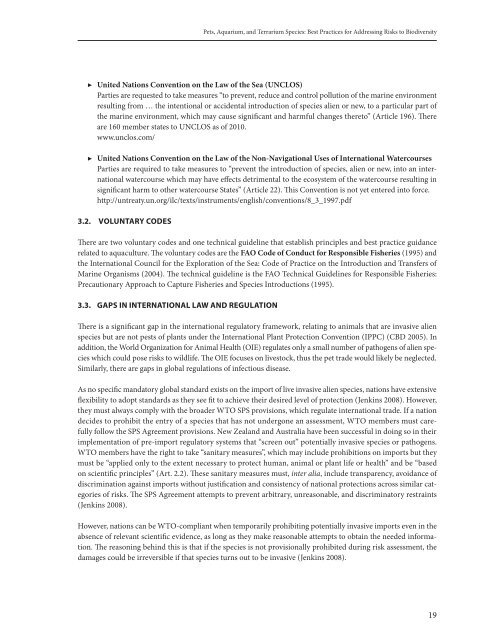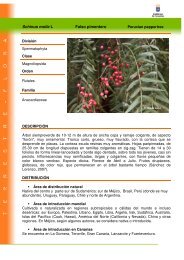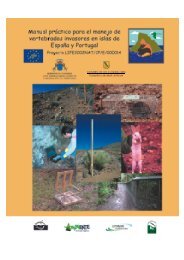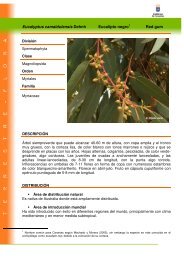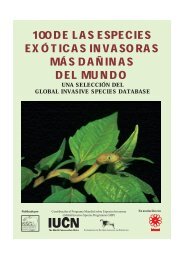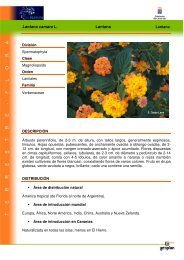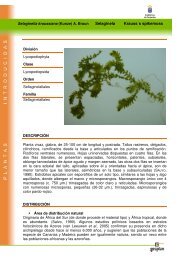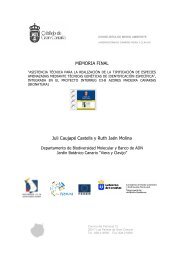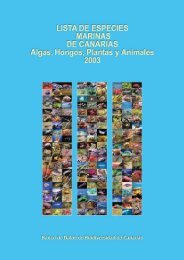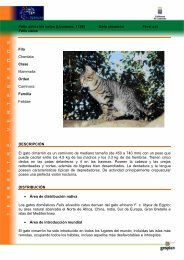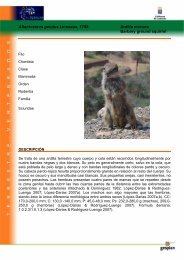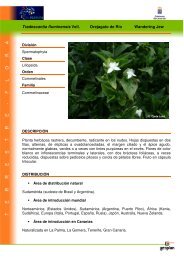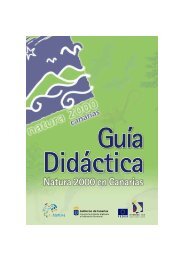Pets, Aquarium, and Terrarium Species - Convention on Biological ...
Pets, Aquarium, and Terrarium Species - Convention on Biological ...
Pets, Aquarium, and Terrarium Species - Convention on Biological ...
Create successful ePaper yourself
Turn your PDF publications into a flip-book with our unique Google optimized e-Paper software.
<str<strong>on</strong>g>Pets</str<strong>on</strong>g>, <str<strong>on</strong>g>Aquarium</str<strong>on</strong>g>, <str<strong>on</strong>g>and</str<strong>on</strong>g> <str<strong>on</strong>g>Terrarium</str<strong>on</strong>g> <str<strong>on</strong>g>Species</str<strong>on</strong>g>: Best Practices for Addressing Risks to Biodiversity<br />
▶▶<br />
United Nati<strong>on</strong>s <str<strong>on</strong>g>C<strong>on</strong>venti<strong>on</strong></str<strong>on</strong>g> <strong>on</strong> the Law of the Sea (UNCLOS)<br />
Parties are requested to take measures “to prevent, reduce <str<strong>on</strong>g>and</str<strong>on</strong>g> c<strong>on</strong>trol polluti<strong>on</strong> of the marine envir<strong>on</strong>ment<br />
resulting from … the intenti<strong>on</strong>al or accidental introducti<strong>on</strong> of species alien or new, to a particular part of<br />
the marine envir<strong>on</strong>ment, which may cause significant <str<strong>on</strong>g>and</str<strong>on</strong>g> harmful changes thereto” (Article 196). There<br />
are 160 member states to UNCLOS as of 2010.<br />
www.unclos.com/<br />
▶▶<br />
United Nati<strong>on</strong>s <str<strong>on</strong>g>C<strong>on</strong>venti<strong>on</strong></str<strong>on</strong>g> <strong>on</strong> the Law of the N<strong>on</strong>-Navigati<strong>on</strong>al Uses of Internati<strong>on</strong>al Watercourses<br />
Parties are required to take measures to “prevent the introducti<strong>on</strong> of species, alien or new, into an internati<strong>on</strong>al<br />
watercourse which may have effects detrimental to the ecosystem of the watercourse resulting in<br />
significant harm to other watercourse States” (Article 22). This <str<strong>on</strong>g>C<strong>on</strong>venti<strong>on</strong></str<strong>on</strong>g> is not yet entered into force.<br />
http://untreaty.un.org/ilc/texts/instruments/english/c<strong>on</strong>venti<strong>on</strong>s/8_3_1997.pdf<br />
3.2. Voluntary Codes<br />
There are two voluntary codes <str<strong>on</strong>g>and</str<strong>on</strong>g> <strong>on</strong>e technical guideline that establish principles <str<strong>on</strong>g>and</str<strong>on</strong>g> best practice guidance<br />
related to aquaculture. The voluntary codes are the FAO Code of C<strong>on</strong>duct for Resp<strong>on</strong>sible Fisheries (1995) <str<strong>on</strong>g>and</str<strong>on</strong>g><br />
the Internati<strong>on</strong>al Council for the Explorati<strong>on</strong> of the Sea: Code of Practice <strong>on</strong> the Introducti<strong>on</strong> <str<strong>on</strong>g>and</str<strong>on</strong>g> Transfers of<br />
Marine Organisms (2004). The technical guideline is the FAO Technical Guidelines for Resp<strong>on</strong>sible Fisheries:<br />
Precauti<strong>on</strong>ary Approach to Capture Fisheries <str<strong>on</strong>g>and</str<strong>on</strong>g> <str<strong>on</strong>g>Species</str<strong>on</strong>g> Introducti<strong>on</strong>s (1995).<br />
3.3. Gaps in Internati<strong>on</strong>al Law <str<strong>on</strong>g>and</str<strong>on</strong>g> Regulati<strong>on</strong><br />
There is a significant gap in the internati<strong>on</strong>al regulatory framework, relating to animals that are invasive alien<br />
species but are not pests of plants under the Internati<strong>on</strong>al Plant Protecti<strong>on</strong> <str<strong>on</strong>g>C<strong>on</strong>venti<strong>on</strong></str<strong>on</strong>g> (IPPC) (CBD 2005). In<br />
additi<strong>on</strong>, the World Organizati<strong>on</strong> for Animal Health (OIE) regulates <strong>on</strong>ly a small number of pathogens of alien species<br />
which could pose risks to wildlife. The OIE focuses <strong>on</strong> livestock, thus the pet trade would likely be neglected.<br />
Similarly, there are gaps in global regulati<strong>on</strong>s of infectious disease.<br />
As no specific m<str<strong>on</strong>g>and</str<strong>on</strong>g>atory global st<str<strong>on</strong>g>and</str<strong>on</strong>g>ard exists <strong>on</strong> the import of live invasive alien species, nati<strong>on</strong>s have extensive<br />
flexibility to adopt st<str<strong>on</strong>g>and</str<strong>on</strong>g>ards as they see fit to achieve their desired level of protecti<strong>on</strong> (Jenkins 2008). However,<br />
they must always comply with the broader WTO SPS provisi<strong>on</strong>s, which regulate internati<strong>on</strong>al trade. If a nati<strong>on</strong><br />
decides to prohibit the entry of a species that has not underg<strong>on</strong>e an assessment, WTO members must carefully<br />
follow the SPS Agreement provisi<strong>on</strong>s. New Zeal<str<strong>on</strong>g>and</str<strong>on</strong>g> <str<strong>on</strong>g>and</str<strong>on</strong>g> Australia have been successful in doing so in their<br />
implementati<strong>on</strong> of pre-import regulatory systems that “screen out” potentially invasive species or pathogens.<br />
WTO members have the right to take “sanitary measures”, which may include prohibiti<strong>on</strong>s <strong>on</strong> imports but they<br />
must be “applied <strong>on</strong>ly to the extent necessary to protect human, animal or plant life or health” <str<strong>on</strong>g>and</str<strong>on</strong>g> be “based<br />
<strong>on</strong> scientific principles” (Art. 2.2). These sanitary measures must, inter alia, include transparency, avoidance of<br />
discriminati<strong>on</strong> against imports without justificati<strong>on</strong> <str<strong>on</strong>g>and</str<strong>on</strong>g> c<strong>on</strong>sistency of nati<strong>on</strong>al protecti<strong>on</strong>s across similar categories<br />
of risks. The SPS Agreement attempts to prevent arbitrary, unreas<strong>on</strong>able, <str<strong>on</strong>g>and</str<strong>on</strong>g> discriminatory restraints<br />
(Jenkins 2008).<br />
However, nati<strong>on</strong>s can be WTO-compliant when temporarily prohibiting potentially invasive imports even in the<br />
absence of relevant scientific evidence, as l<strong>on</strong>g as they make reas<strong>on</strong>able attempts to obtain the needed informati<strong>on</strong>.<br />
The reas<strong>on</strong>ing behind this is that if the species is not provisi<strong>on</strong>ally prohibited during risk assessment, the<br />
damages could be irreversible if that species turns out to be invasive (Jenkins 2008).<br />
19


